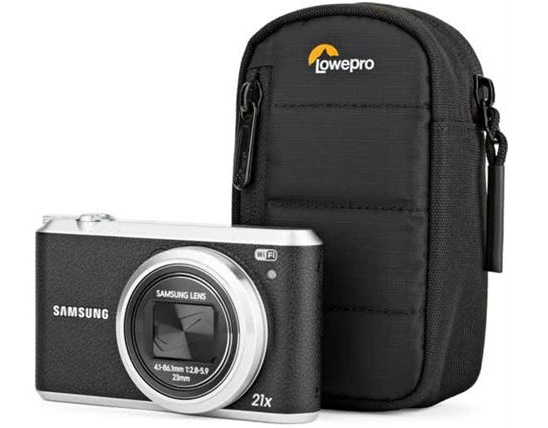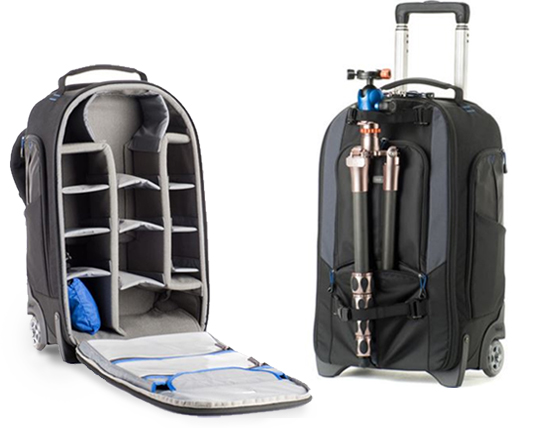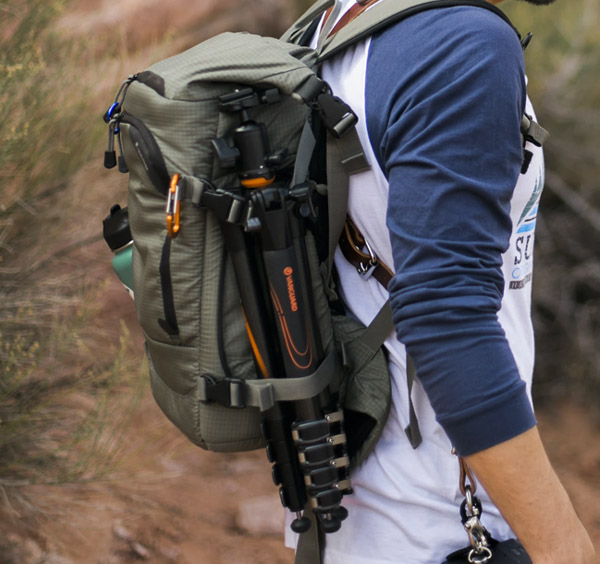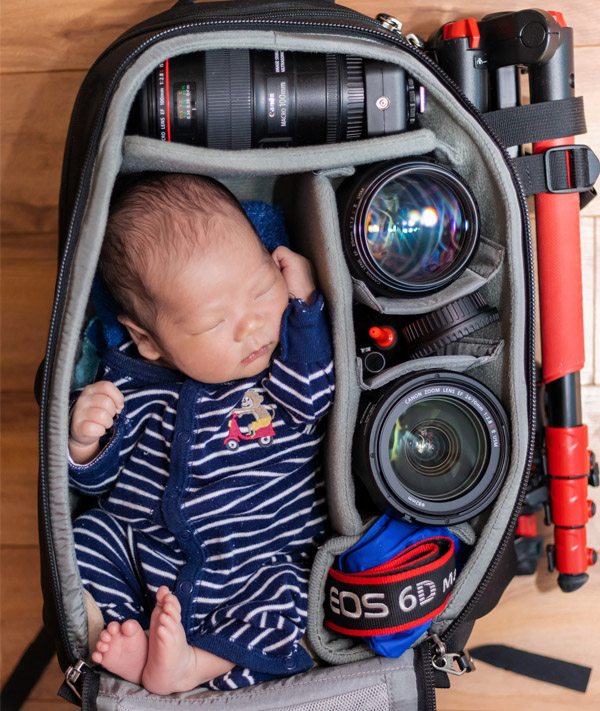
Camera, check. Lens, check. Memory cards, check. Holiday, check. But how does everything go with you? A camera bag is a must-have for the photographer on the go. Whether you are going on holiday or just out and about. There is a wide range of bags especially for photographic equipment. Unlike normal bags, camera bags are equipped with several compartments that keep your equipment in its proper place. That means your valuables are well protected.
What bags are there | Which bag will you choose?
The smallest type of camera bag is the case, intended for compact cameras. Its big advantage is that it is small in size and therefore easy to store in, for example, a larger bag or your trouser or jacket pocket. The case protects the camera from dirt, dust and scratches. Make sure your compact camera fits well in the case without leaving too much space. That way, you can be sure that your camera will not slide around and get damaged. The small size is handy, but it does not allow you to store much else. Some cases still have space for a memory card or battery.

Very compact and easy to carry in your pocket or another bag
Offers protection against drops, scratches and dust
Available in many sizes, so always tailor-made for your compact camera
Storage options are limited
Not suitable for larger cameras
You could think of the muzzle bag as the case for an SLR or system camera. Like the case, it is (if all goes well) exactly sized for your camera, including a lens. That means it is well protected against drops and bumps. The size, obviously depending on your camera, is manageable and still allows you to easily tuck it away in another bag when travelling if you don't want to constantly walk with it around your neck. Most muzzle bags come with a carrying strap, so you can also hang it around your neck or shoulder as a full-fledged bag. The opening at the top allows you to grab your camera to take a picture in seconds.
Space for an SLR or system camera and lens
Opening at the top for quick access to your camera
Easy to carry thanks to compact size
Different formats, always tailored to your equipment
Often space for small accessories such as memory cards and batteries
No possibility to carry extra lenses
Often no space for larger accessories such as chargers and flash units
The shoulder bag offers space for more than just the basics. It comes in different shapes and sizes so there is always one to suit your gear. This also makes the shoulder bag suitable for enthusiastic image-makers with, for example, two bodies and multiple lenses and accessories. The interior is divided into several compartments that you can often customise to your liking. A bag with lots of storage options brings us straight to the downside of the shoulder bag: carrying comfort. It's nice to go out with a lot of stuff, but you have to remember that all that weight all ends up on one shoulder. On the other hand, you have quick access to the bag and don't have to take it off to access your stuff.
Space for more than just your camera, all accessories can go with it
Different compartments for all equipment, often on the inside and outside
Often adjustable partitions for self-arranging the interior
Easy access to your belongings without having to take off the bag
No sweaty backs on hot days
Carrying comfort with a heavily loaded shoulder bag; all the weight comes on one shoulder
Awkward if you need to be agile and have to, for example, bend your knees
View all shoulder bags View our Top 10 shoulder bags
What a backpack is, of course, we don't have to explain to you. Just like a shoulder bag, it comes in all sorts of sizes so there is always one to suit your needs. Since the weight is distributed over two shoulders, you can load the bag up quite nicely without immediately causing discomfort to your shoulders and back. There are also backpacks with a waist belt that distributes the weight even more finely over your upper body. A backpack has several compartments and sometimes offers space for extra personal items, such as a jumper, some food or a laptop. Some models also allow you to store a tripod or water bottle on the side. A backpack fits a lot of stuff, but you sacrifice speed. This is because you have to take the bag off your back completely to reach your stuff.
Plenty of capacity for multiple bodies and/or lenses
Often space for more than just your photo equipment
Heavier load possible thanks to good distribution by two shoulder straps, harness and sometimes a waist belt
The interior can often be customised to suit your needs
Sometimes space to attach a tripod on the outside
You don't have your camera in hand within seconds
View all backpacks View our Top 10 backpacks
A sling bag is worn around one shoulder and on your back. Therefore, you could think of it as a combination between the shoulder and back bag. This is because it offers (partly) the carrying comfort of a backpack and partly the ease of use of a shoulder bag. When you want to grab your camera, you slide the bag from your back to the front, where you have quick and easy access to your camera without having to take off your bag. Although the carrying comfort is better than with the shoulder bag, all the weight still ends up on your shoulder. An extra strap under your arm through does ensure that the bag stays firmly against your back. In terms of capacity, of course, it varies from model to model, but normally a sling bag can hold a lens or other accessories such as a flash, in addition to your camera and a lens.
Ease of use of a shoulder bag, but slightly more comfortable to carry
Quick access to your camera without having to take off the bag
Space for more than just your camera and lens
The bag sits securely on your back, relieving your back and shoulder muscles
Often fairly compact in size
With heavy loading, the weight is not evenly distributed anyway
View all sling bags View our Top 10 sling bags
A photo trolley is a compact and practical solution when you want to take a lot of gear with you, but don't have the space for a large suitcase. Thanks to its size and the wheels on the bottom of the trolley, it is ideal as hand luggage for your flight or train journey. However, you shouldn't make it too adventurous, as trolleys still roll most comfortably on flat surfaces. Some trolleys are also equipped with shoulder straps, allowing you to carry it on your back, temporarily or otherwise.

Plenty of storage space for all your equipment
Wheels make sure you hardly notice the weight
Useful for air or train travel
Less suitable for adventure trips
There is no better way to protect your precious equipment than in a case. A good case protects against shocks and drops. Most manufacturers even guarantee that you can drive a car over it! Differences in air pressure and extreme weather conditions are not a problem either. That means you can feel free to take it on a plane. When buying a suitcase, you can choose between two variants in terms of the interior: plush foam that you customise according to your belongings, or dividers. The latter are a kind of dividers. A suitcase is especially useful for professional purposes and you won't just take it on a city trip.
Ultimate protection of your valuable equipment
Highly suitable for professional purposes
Resistant to all kinds of influences
Not so easy to carry
Not really suitable for the hobby photographer on a city break
View all cases View our Top 10 cases
You now know what's on the market and the pros and cons of each type of bag. But which bag is the right one for you? To make a good choice, it is important to think about a few things.
The type, but especially the size of the camera, largely determines which bag you should choose. If you shoot with a compact camera, then a case is probably the best choice. If you have a system or SLR camera with interchangeable lenses, you will end up with larger bags.
A camera and lens can fit nicely in a snout bag, but if you want to take an extra lens with you, you'd better orient yourself towards a larger bag.
Do you go out with just the basics or do you take all kinds of accessories with you? Or perhaps other personal items for the road? This will determine the capacity of the bag. Also look carefully to see if and how you can make use of the extra compartments.
Want to be able to edit photos on your laptop right away? Then it's best to choose a bag with a special laptop compartment. That way, you can be sure it will be well protected.

An easy way to take your tripod with you
A tripod is always handy as a photographer. Unfortunately, it does not fit in the bag, but fortunately there are bags where you can easily attach it to the outside. That saves lugging around an extra tripod bag.
If you work in situations where there is a rush, you don't want to have to take off an entire bag first to grab your camera. Then you will benefit more from quick access to your camera from a sling or shoulder bag, for example. If you are in no hurry at all because you are mostly working on location or in the studio, consider a suitcase, trolley or backpack.
If you do a lot of walking, don't skimp on carrying comfort. Especially if your bag is heavily loaded, your shoulders and back will thank you at the end of the day. The best option then is probably the backpack. If you only carry the bag for small stretches, you can of course opt for a shoulder bag or suitcase. For avid hikers, a pocket or net for a water bottle is no luxury either.

Be prepared for future expansion
A few hours away from your hotel or weeks on the road, that's quite a difference. For short trips, a small bag is often enough. If you go a bit longer, you might need more space.
Maybe not the first thing you think of, but still important. In a busy city, you don't really want your bag to radiate that it contains expensive equipment. Fortunately, there are also bags that look like normal bags. That way, you don't show that there's something to be taken from you.
You won't be the first to buy a new lens and then find out that it all no longer fits in the bag. So start thinking about whether you want to expand your gear in the future, then you can base your choice on this.
In the end, it's just really important whether the bag feels right to you. That's about the design, but also about the comfort of carrying it. That is different for everyone.